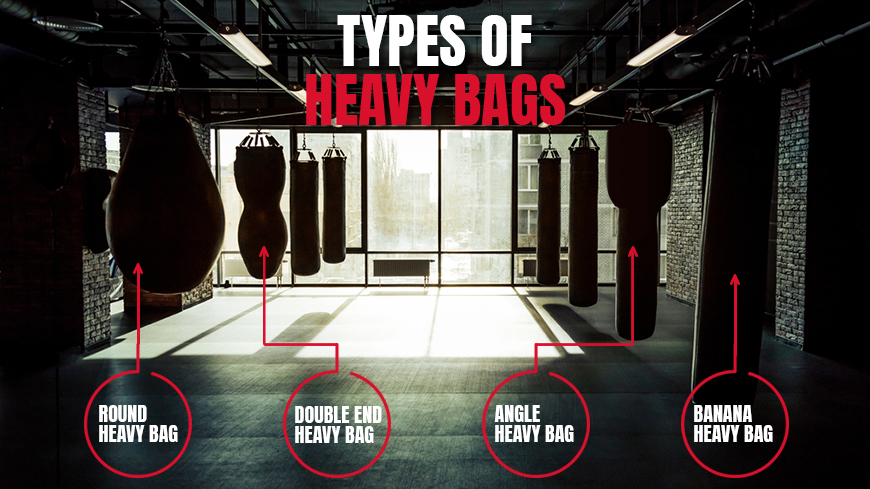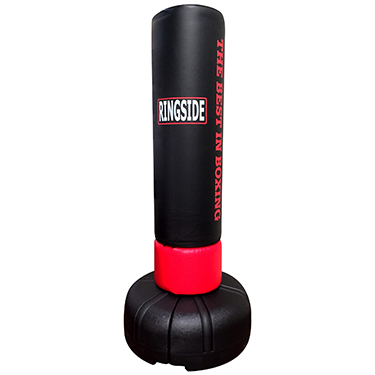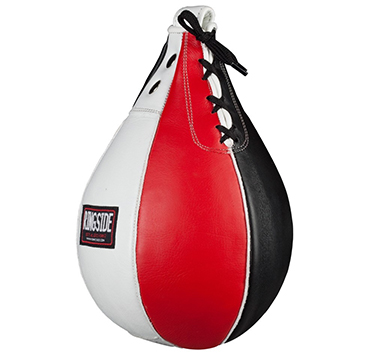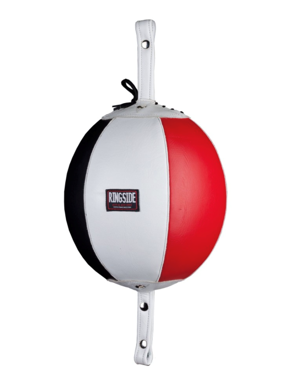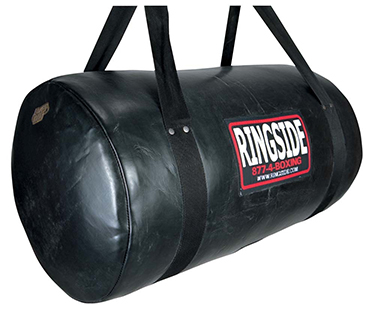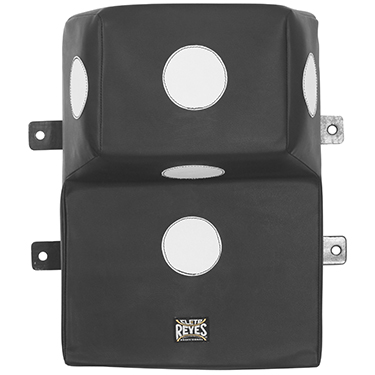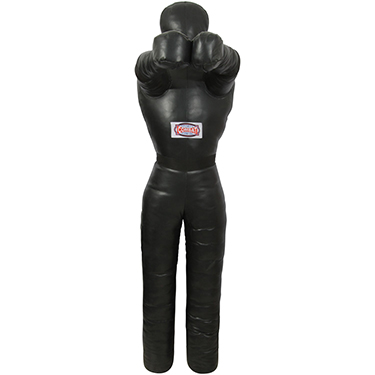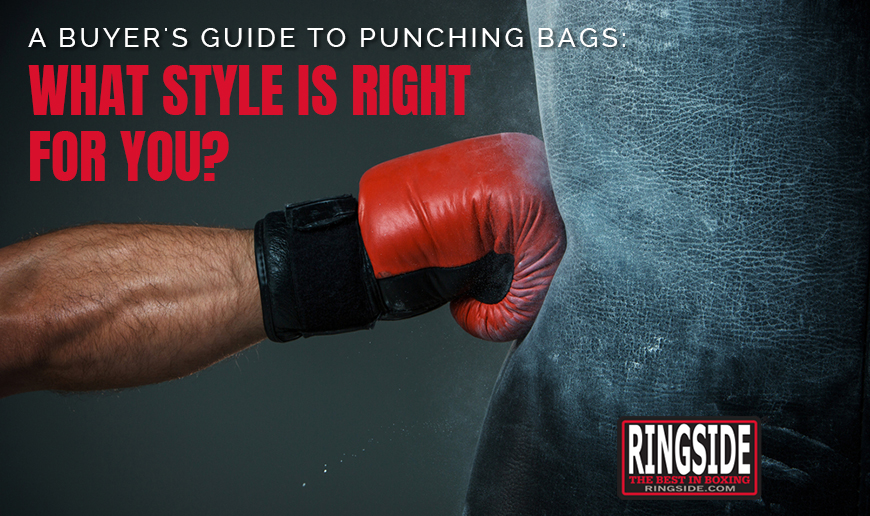 For an aspiring boxer, mixed martial artist or fighter in training, there’s no piece of equipment more vital than the punching bag. Punching bags act as practice targets for helping you develop and perfect your punching and kicking techniques.
For an aspiring boxer, mixed martial artist or fighter in training, there’s no piece of equipment more vital than the punching bag. Punching bags act as practice targets for helping you develop and perfect your punching and kicking techniques.
Just like the rest of your sports equipment, your punching bag should mesh with your particular athletic goals. Understanding which style, size and material you need is essential to your training.
TYPES OF PUNCHING BAGS
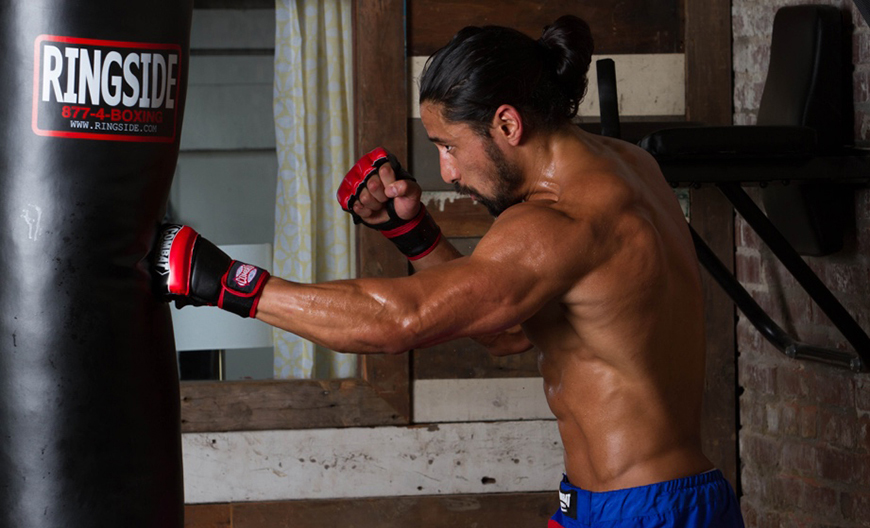
There are several different punching bag styles to consider, based on the sport you’re in and your training goals. The heavy bag — ideal for improving your overall technique — may not be appropriate for an athlete looking to improve speed, reflex and reaction time. A speed bag won’t be used for polishing your front kicks. The right bag for kickboxing may not be the best one for Muay Thai, and so on.
At Ringside, we have nearly 200 unique punching bags to consider to suit your specific goal, sport, athletic build and budget. Here are a few of the most popular kinds:
Heavy Bag
These large, heavy-duty punching bags are typically suspended from the ceiling so that they can withstand a lot of impact. In general, heavy bags are designed for improving overall punching and kicking technique. Your “standard” heavy bags are cylindrical, but heavy bags come in several different shapes and sizes. They weigh between 30 and 200 pounds and are typically hung with a chain, swivel or rope. Choose this kind of bag for boxing, MMA, Muay Thai, karate and more.
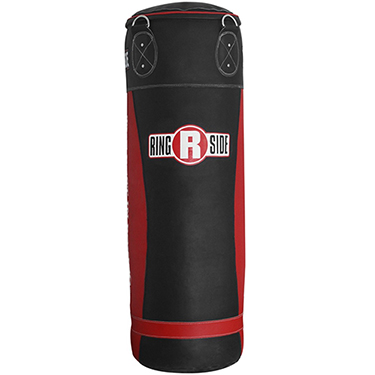
OUR PICK: RINGSIDE LARGE LEATHER HEAVY BAG
Other Types of Heavy Bags
- Muay Thai Heavy Bag (aka Banana Bag) — A slimmer and longer version of the typical heavy bag, the Muay Thai heavy bag is designed differently for training low kicks and knee strikes. These kinds of bags are often used in Muay Thai and MMA.
- Round Heavy Bag — Short, spherical heavy bags, or those with teardrop shapes, may be used to hone in on certain body punches. For example, you may use what’s known as a “wrecking ball” heavy bag if you want a heavyweight bag that will help you perfect more targeted kicks and punches.
- Angle Heavy Bag — The angled heavy bag usually features a top-heavy design with a broader top portion and a slimmer trunk. These kinds of punching bags allow you to throw better straight punches, hooks, uppercuts and body shots.
- Double End Heavy Bag — The double end heavy bag is like the angle bag, but it features two dramatic angles — think of an hourglass shape. The benefit of this is that it allows athletes to train body-head combinations, since the silhouette of the bag roughly mimics that of an opponent.
Free-Standing Punching Bag
Free-standing punching bags, as the name implies, do not require any kind of fixed mounting system. While most punching bags are required to be hung from the ceiling or attached to the wall, free-standing bags are mounted on a heavy, durable base. This allows them to placed anywhere that there is room. They are also easily re-positioned to allow a space to have multiple uses. Typically these types of bags have a spring-loaded design so that the bag returns to the fighter when hit. This type of recoil offers a very different speed and movement than might be expected from a standard-mounted bag, delivering a different challenge to the fighter. The free-standing bags are great for practicing the low kicks common to Muay Thai and other mixed martial arts. They are ideal for home use or gyms where ceiling or wall installation is not an option.
OUR PICK: RINGSIDE ELITE FREESTANDING FITNESS PUNCHING BAG
Speed Bag
As its name suggests, the speed bag is meant to help athletes improve their fast-paced punches, by assisting with with strength, timing, endurance and specific goals, such as helping fighters learn to keep their hands up or building shoulder strength. Speed bags are filled with air and are significantly smaller than heavy bags, so they’re often suspended from the ceiling or wall with a platform. They’re usually shaped like a globe or a teardrop and are most commonly used for traditional boxing training.
OUR PICK: RINGSIDE BOXING SPEED BAG
Double End Bags
Double-end bags are meant to help athletes land an effective counter punch by sharpening reflexes, improving speed and hand/eye coordination, and effectivity nailing down a sense of timing and rhythm. Double end bags come in various sizes depending on the fighter’s needs and can be mounted from a wall or ceiling.
OUR PICK: RINGSIDE BOXING DOUBLE END BAG
Uppercut Bag
Unsurprisingly, the uppercut bag is uniquely designed for focused uppercut practice. It can also be used for straight punches, such as jabs and crosses, hooks and more. These kinds of bags can be mounted onto the wall or ceiling, depending on their shape and size. We recommend uppercut bags for serious boxing athletes.
OUR PICK: RINGSIDE UPPERCUT HEAVY BAG
Wall Bag
Wall punching bags can be used for a wide range of training endeavors and in gyms or training facilities with high or vaulted ceilings. Unlike typical bags, these bags are mounted to the wall and don’t provide any rebound or swivel. Otherwise known as mounted punching bags, these bags are much less common than swinging bags, but may be a good choice in environments where typical ceiling mounting isn’t an option.
OUR PICK: CLETO REYES WALL BAG
Grappling Dummy
Arguably the most lifelike punching bags around, grappling dummies look like a human opponent, often complete with a head, legs and hands. Grappling dummies are generally freestanding (not mounted to the wall or ceiling) and don’t have a base to keep them rooted, which allows you to perfect your takedowns, throws, submissions and strikes. These are commonly employed in wrestling and MMA, including jiu-jitsu and judo.
OUR PICK: COMBAT SPORTS LEGGED GRAPPLING DUMMY
CHOOSING SIZE AND WEIGHT OF PUNCHING BAG
The primary considerations for choosing a punching bag size are the fighter’s age and size. Just like in a real bout, a fighter should be matched with a bag that works well with his or her own height and weight. Punching bags come in sizes ranging from 2.5 feet to 6 feet and weights ranging from 60 pounds to 150-plus pounds, but this is not a hard and fast rule. You’ll find bags in a variety of heights, widths and weights. Some punching bags have integrated mechanisms that allow you to adjust the weight as needed.
A quick note about choosing kids’ punching bags for youth trainers. Youth punching bags weigh significantly less than standard, adult-sized bags. Because the blows will be less powerful from a youth fighter, these bags don’t require the same amount of strength or impact absorption. The focus of these bags is not on strength or power training, but on developing technique.
For adults, of course, you’ll need to choose a larger and heavier bag. But which size is right for you or your clients?
The general rule for sizing your adult heavy bag is that it should be approximately half your weight. For example, if you weigh 160 pounds, you should choose an 80-pound punching bag. Heavy bags that are 4 or 5 feet long are usually sufficient for adults. As long as you have enough resistance and steadiness — i.e. the bag doesn’t flail wildly in every direction each time you land a square punch — then you should be in good shape, size-wise.
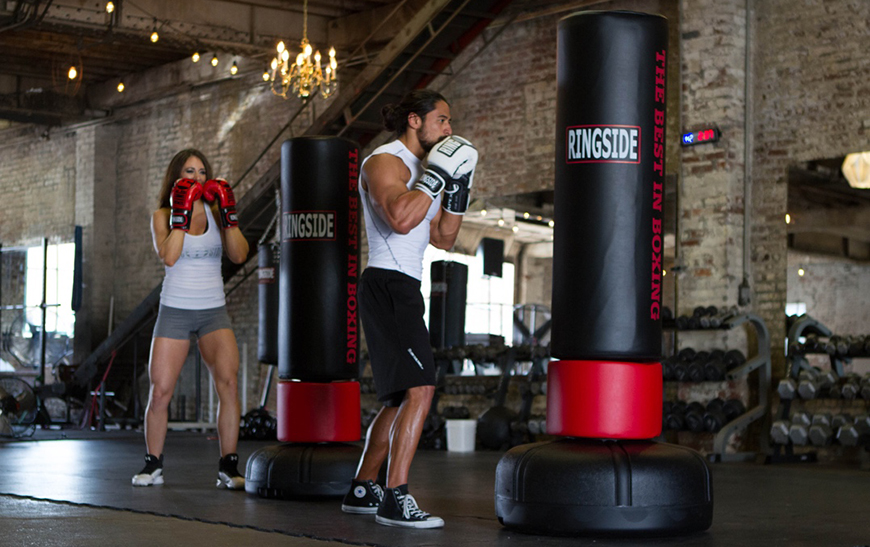
PUNCHING BAG SURFACE MATERIAL
In general, punching bags are made of either leather or a synthetic material, such as vinyl or plastic. Leather punching bags are the most traditional and are still arguably the gold standard, desired because they’re incredibly durable and comfortable, not to mention classic in aesthetic.
With that being said, leather tends to be more expensive than man-made materials. For this reason, many punching bag brands utilize a lifelike synthetic leather that provides a similar feel as leather without the high cost.
Still, synthetic punching bags do bring some advantages, especially in specific environments. For example, vinyl and nylon may be better suited to humid spaces because they’re more resistant to developing mold and mildew. Occasionally, you might see a bag constructed from canvas. While much less durable than genuine and synthetic leather, canvas punching bags are extremely affordable and can be good in very low-use scenarios.
PUNCHING BAG FILL MATERIAL
The final consideration in punching bag selection is the fill, AKA what’s inside the bag. The fill determines the firmness, comfort, weight and even the cost of your punching bag. In most cases, your punching bag will come pre-filled, but you may need to buy filler for a bag that was sold empty or refill it as needed if you’ve had a leak or the fill has begun to disintegrate. The most popular punching bag fillers include:
- Sand — Naturally, sand is the best option for people who want maximum weight in their punching bag. Sand is easy to fill into almost any reservoir and, unlike water, won’t cause a huge mess if it leaks. On the other hand, sand tends to change in hardness if it’s exposed to moisture and may leak out of the bag’s reservoir into other areas.
- Water — Water-filled heavy bags are convenient, since most of us have water nearby at all times. Today’s water bags are more dependable, reliable and safer to punch. Usually, water-filled punching bags have a “bladder,” which allows for easy filling and prevents breakage.
- Air — Often used in speed bags and double end bags, air is a cheap and convenient filler for those who need a lighter weight option. The primary downfall of air-filled punching bags is that most tend to deflate slightly with constant use, so they will need to be refilled every couple of days.
- Textile — Punching bags that use textile fillings are good for applications where you want to reduce muscle strain on the wrist, elbows and shoulders. The material is relatively soft, lightweight and conforming. Most standard and muay thai style heavy bags use a combination of textile and sand fill to provide the right amount of weight and impact feel.
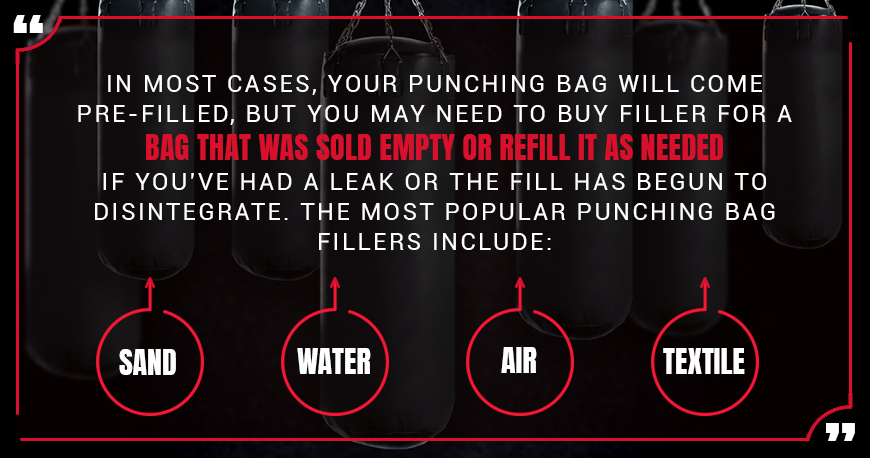
NEED MORE INFORMATION ON PUNCHING BAGS? CONTACT US
We know that shopping for punching bags, and fighting gear in general, can be a tough task. With so many options to weigh, it takes a bit of time and effort to pick out a punching bag that’s a perfect match for you or your customers. If you’re still not sure which one is best for you, the team here at Ringside is always available to provide you with one-on-one advice. Contact us today if you need more information or product recommendations. And if you want more great information from Ringside, or to be kept up-to-date on our latest deals, sign up for our email newsletter.


